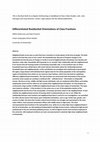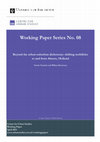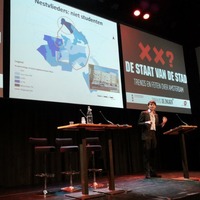Papers by Willem R. Boterman

City, 2018
Suburbanisation has been a prevalent process of postwar, capitalist urban growth, leading to the ... more Suburbanisation has been a prevalent process of postwar, capitalist urban growth, leading to the majority of citizens in many advanced capitalist economies currently living in the suburbs. We are also witnessing, however, the reverse movement of the increasing return to the inner-city. This contradiction raises questions regarding contemporary urban growth and the socio-spatial production of the suburbs. This paper draws on the case of new town Almere in the metropolitan region of Amsterdam to cast light upon the changing suburban–urban relationship, by investigating the mobility to and from Almere for two decades through socioeconomic, demographic data between 1990 and 2013. We demonstrate that Almere has developed from a typically suburban family community to a receiver of both international unmarried newcomers and families; its population has also become relatively poorer, yet the levels of upwards income mobility have remained stable. These trends emphasise alternative types of mobilities emerging in concert to the more typical suburban migration. The town's transformation challenges the urban–suburban dichotomy, pointing to alternative explanations of contemporary urban growth and metropolitan integration.

Economic restructuring and changing demographic and migration patterns have significantly altered... more Economic restructuring and changing demographic and migration patterns have significantly altered the population compositions of urban regions. While there is evidence that employees in various sectors of the economy have different residential preferences, much less insight exists into the social geography of various class fractions at the level of urban regions. The aims of this paper are: 1) to describe the spatial orientations of various employment groups in the largest urban regions in the Netherlands, and 2) to understand the extent to which spatial orientations towards various residential urban and suburban milieus can be explained by belonging to a specific class fraction. We draw on individual-level register data for the whole population of urban regions, applying a multidimensional and detailed perspective on social class that takes into account both economic and cultural capital. We demonstrate a strong urban orientation among the cultural classes, who are often working in the 'new economies' – irrespective of their income status – and an overrepresentation in suburban areas of more economically-orientated class fractions. Despite the differences in terms of economic structure of the researched urban regions, these variegated residential orientations are remarkably consistent.
This paper discusses state interventions in a poor former-working-class area in Amsterdam – Van d... more This paper discusses state interventions in a poor former-working-class area in Amsterdam – Van der Pekbuurt. Even though the residents have been successful in resisting redevelopment and renovation plans, state and housing association continue their efforts to change the area through symbolic politics. By introducing and facilitating cultural entrepreneurs and artists in the area - as part of regeneration and gentrification strategies -, the representation of what the neighborhood is, and ought to be, gravitates towards the planners’ future vision. As such, these representations undermine the legitimacy of long-term residents. Interviews with residents reveal that the change in the neighborhood instill a sense of loss of place, exacerbated by cuts in local service provision.

In recent decades, neighbourhood regeneration has often involved social mixing strategies, often ... more In recent decades, neighbourhood regeneration has often involved social mixing strategies, often through comprehensive renewal. By deconcentrating poverty and giving opportunities for social interaction, remaining residents are believed to benefit from middle class presence. This study looks at a post-war neighbourhood in Amsterdam which has undergone comprehensive renewal. By making use of survey data in combination with GIS techniques, this study shows that perceptions are
structured by physical characteristics, activity patterns and symbolic boundaries. These perceptions are highly dependent on social position. While some residents in renewal areas display inclusionary attitudes, there is also evidence of middle class and lower class disaffiliation. Interestingly, these translate into different mental maps for both groups. The paper ends with a methodological reflection on using GIS-based boundary drawing in neighbourhood surveys to gauge fragmentation and place-based displacement.

This city profile provides a multi-dimensional overview on the most recent social, economic, poli... more This city profile provides a multi-dimensional overview on the most recent social, economic, political and spatial changes in the city of Amsterdam. We map the social-geography of the city, discussing recent housing and spatial development policies as well as city-regional political dynamics. Today, the city of Amsterdam is more diverse than ever, both ethnically and socially. The social geography of Amsterdam shows a growing core–periphery divide that underlines important economic and cultural asymmetries. The tradition of public subsidies and regulated housing currently allows for state-led gentrification within inner city neighborhoods. Public support for homeownership is changing the balance between social, middle and high-end housing segments. Changes in the tradition of large-scale interventions and strong public planning are likewise occurring. In times of austerity, current projects focus on small-scale and piecemeal interventions particularly oriented to stimulate entrepreneurialism in selected urban areas and often relate to creative economies and sustainable development. Finally, underlying these trends is a new political landscape composed of upcoming liberal and progressive parties, which together challenge the political equilibriums in the city region

Although one’s neighbourhood is continuously structuring everyday lives and influences encounters... more Although one’s neighbourhood is continuously structuring everyday lives and influences encounters between different people, place of residence is only partially the site where interactions and possibly integration between population categories occur. Another well-known domain is the place of work, where many spend hours per day and may meet various ‘others’. However, people’s mobility is also strongly differentiated between class and ethnicity. Here too, different modes of transport may offer opportunities for encounter and engaging with others. In order to assess exposure to diversity of individuals from various ethnic and social class backgrounds to ‘the other’ we focus on these three important realms of daily life: neighbourhoods, workplaces and modes of transport. We use individual level data from the Mobilities Netherlands Database combined with detailed individual level register data from the Social Statistical Database. We found that, overall, higher income natives are, compared to the other combinations of country of origin and income category most frequently cocooning in homogeneous residential, workplace, and mobility spaces. However, native Dutch with a low income stand out in the residential domain, where they are living more frequently in homogeneous neighbourhoods than high-income natives.

Abstract
Neighbourhoods can be seen as units that have a function in certain phases of the lives ... more Abstract
Neighbourhoods can be seen as units that have a function in certain phases of the lives of people. The ideal seems to be that they more or less ‘match’ the household type. Because of frequent changes in the household and also because of changes or inertia in several neighbourhoods mismatches may develop and therefore, when able, households will frequently try to ‘rematch’ their relationship with the neighbourhood. If we assume that the housing market is functioning reasonably well, a cross-sectional view on where household types have settled down will reveal relevant information about the relationship between household types and neighbourhoods. In this contribution we investigate that relationship in great detail. We apply a large dataset with individual level register data for the whole population of the metropolitan region of Amsterdam from which we can construct class fractions, which form the basis for explaining different neighbourhood orientations. The class fractions are constructed with information of the precise economic sector people are working in combined with – individual level – information on disposable income. We focus on low, middle and high income individuals, who are employed within fifteen contrasting employment sectors and for which we can analyse their neighbourhood orientation. For that purpose we constructed a large number of different neighbourhood types in the urban region of Amsterdam. The types were based on whether: 1) the location is in the urban core or not; 2) the population density of the neighbourhood and the size of the municipality; 3) housing real estate values in the neighbourhood; 4) and whether the neighbourhood consists of housing which is predominantly pre-war or not. While the relationship between class fractions and neighbourhood types is central to our investigations, we controlled for other obvious factors that impact upon residential orientations, such as age, family type, gender, and country of origin. We show that creative cultural class fractions are strongly overrepresented in the most urban milieus, more precisely Amsterdam milieus with middle status or high status. The most overrepresented class fractions in the metropolitan area, which are in urban high status neighbourhoods in the city of Amsterdam, are self-employed (independent) and high-income lawyers, followed by high-income professionals in the arts and book publishing sectors, as well as highest income class fractions employed at the university. Self-employed architects are most overrepresented in suburban high status neighbourhoods in Amsterdam.

Parental support, in both financial and non-financial ways, is important in explaining the reside... more Parental support, in both financial and non-financial ways, is important in explaining the residential
trajectories of young people leaving home. For instance, the influence of parental support on the
ability to leave home or enter homeownership is well established. This study adds a dimension by
investigating how inequalities in terms of parental background – particularly assets – are spatially
articulated. More specifically, we study whether parental background influences the types of
neighbourhoods young people leaving home move to. Drawing on the case of Amsterdam, we
show that these ‘fledglings’, despite their generally very modest income, disproportionally move
to gentrification neighbourhoods. Moreover, fledglings with wealthy parents are even more likely
to move to both early gentrifying and expensive mature-gentrification neighbourhoods.
Gentrification research should therefore also take into account the importance of middle class
social reproduction strategies as well as the potential intergenerational transfer of (financial)
resources – rather than merely personal financial situation – in shaping housing outcomes and
spatial inequalities of young people leaving home. Drawing on parental support, young people
may be able to outbid other households and hence exclude them from gentrifying neighbourhoods.
Consequently, parental wealth and other resources can thus contribute to gentrification
and exclusion.

Transactions of the Institute of British Geographers, 2014
ABSTRACT This paper argues that becoming a parent/carer can be seen as a new field of social rela... more ABSTRACT This paper argues that becoming a parent/carer can be seen as a new field of social relations and suggests how gender is the key mechanism in the reconfiguration of class relations in this field. By conceptualising parenthood as a field, that is a social world with specific stakes and rules, this study suggests that residential decisions and strategies developed by different middle-class households do not solely depend on their class habitus, but also on gendered positions and dispositions in respect to division of labour, child care and school choice. Drawing on interview data from London and Amsterdam, this study re-addresses the issue of middle–class time-space trajectories at a specific period in the life course. We contend that the middle classes are not just differentiated by various orientations of capital (economic versus cultural) but that interaction of class and gender is also key for understanding practices of the middle classes as they enter the field of parenthood. These practices are strongly influenced by labour market and welfare regimes (as the Netherlands/England comparison makes clear). In the new field of parenthood the work of realigning class habitus (through social reproduction) is highly gendered, but to different degrees that are made evident in the different neighbourhood settings. In terms of urban space this points to the significance of the particular neighbourhood structure and opportunities of the city as a whole as well as a more active idea of the role of space in the particular working out of class and gender in specific neighbourhood contexts. Urban space is a situating framework and an active process in trajectories of social reproduction.

Tijdschrift voor Economische en Sociale Geografie
Research shows that female participation rates are lower in suburbs than in urban areas. In this ... more Research shows that female participation rates are lower in suburbs than in urban areas. In this paper we explore the residential patterns of the gender division of family households at the level of the neighbourhood. We draw on national register data (SSB) to define various arrangements of the way in which parents with dependent children divide paid work. These household arrangements are plotted onto maps to sketch the geography of division of paid work in Amsterdam. Our findings show that family households with specific gender divisions of paid work tend to cluster in specific residential environments: (1) families who work with a traditional division of labour are concentrated in social-housing estates in neighbourhoods with high shares of non-Western minorities; (2) one-and-a-half earner families are clustered in the most suburban parts of the city; and (3) symmetrical and female-breadwinner households concentrate in central gentrification areas of the city.

This paper takes a broad perspective regarding the success with which young people can leave thei... more This paper takes a broad perspective regarding the success with which young people can leave their parental home and become an independent household in Amsterdam. High demand pressures on the local housing market and the financial crisis are seen to place constraints on the accessibility for young households. Nevertheless, paradoxically, especially the influx of young households currently contributes to Amsterdam’s population growth. However – and most importantly to this paper – previous research suggest that inequalities between different starter groups have grown. These inequalities are often transferred from one generation to the next. Using longitudinal individual register data this paper looks at patterns of inequality between young households with different backgrounds as they make their first steps as independent households. Especially their parental background is of importance to this analysis. Our data suggests that the number of starter households with wealthy parents and...

The Centre for Urban Studies (CUS) houses the Urban Studies Research Priority Area, a strategic i... more The Centre for Urban Studies (CUS) houses the Urban Studies Research Priority Area, a strategic initiative of the University of Amsterdam. It brings together urban scholars in sociology, geography, planning, political science, economics, development studies and other disciplines. The Centre supports existing urban research programs and stimulates interdisciplinary collaborative projects. With 39 academic staff and over 60 PhD students, it is among the largest programmes of its kind in the world. The Centre works closely with both academic and non-academic partners and has developed a variety of institutional relations with other leading institutions. CUS is part of the AISSR, the Abstract Suburbanisation has been a prevalent process of post-war, capitalist urban growth, leading to the majority of citizens in many advanced capitalist economies currently living in the suburbs. We are also witnessing however the reverse movement of the increasing return to the inner-city. This contradiction raises questions regarding the socio-spatial production of current suburbanisation. This paper draws on the case of suburban, new town Almere in the metropolitan region of Amsterdam to cast light upon the changing suburban-urban relationship, by investigating the mobility to and from Almere for two decades through municipal data. We demonstrate that Almere has developed from a typically suburban family community in the 1980s, to nowadays a receiver of both international unmarried newcomers and families, emphasizing alternative types of mobilities emerging in concert to the more typical suburban migration. The town's transformation challenges the urban-suburban dichotomy, pointing to alternative explanations of contemporary urban growth and metropolitan integration. "Over the engines oily rumble and the caresses of the river small sounds, house sounds, are building. Timbers whisper and the wind strokes thatch, walls settle and floors shift to fill space; the tens of houses have become hundreds, thousands; they spread backwards from the banks and shed light from all across the plain." Perdido Street Station -China Mieville
De Yuppies van de jaren negentig zijn Yupps (young urban professional parents) geworden, en velen... more De Yuppies van de jaren negentig zijn Yupps (young urban professional parents) geworden, en velen van hen wonen met hun kinderen nog steeds in de stad. In dit hoofdstuk nemen we Amsterdam als voorbeeld, maar het verschijnsel is niet typisch Nederlands: binnen en buiten Nederland zijn steeds
meer gezinnen met jonge kinderen in de grote stad te vinden. Binnen de Amsterdamse ringweg A10 bevindt zich inmiddels een concentratie gefeminiseerde gezinshuishoudens: de stad als emancipatiemotor. Wat zijn daarvan de achtergronden? En is dit een tijdelijk verschijnsel, bijvoorbeeld als gevolg van de crisis, of een meer structurele ontwikkeling?

This paper argues that becoming a parent/carer can be seen as a new field of social relations and... more This paper argues that becoming a parent/carer can be seen as a new field of social relations and suggests how gender is the key mechanism in the reconfiguration of class relations in this field. By conceptualising parenthood as a field, that is a social world with specific stakes and rules, this study suggests that residential decisions and strategies developed by different middle-class households do not solely depend on their class habitus, but also on gendered positions and dispositions in respect to division of labour, child care and school choice. Drawing on interview data from London and Amsterdam, this study re-addresses the issue of middle–class time-space trajectories at a specific period in the life course. We contend that the middle classes are not just differentiated by various orientations of capital (economic versus cultural) but that interaction of class and gender is also key for understanding practices of the middle classes as they enter the field of parenthood. These practices are strongly influenced by labour market and welfare regimes (as the Netherlands/England comparison makes clear). In the new field of parenthood the work of realigning class habitus (through social reproduction) is highly gendered, but to different degrees that are made evident in the different neighbourhood settings. In terms of urban space this points to the significance of the particular neighbourhood structure and opportunities of the city as a whole as well as a more active idea of the role of space in the particular working out of class and gender in specific neighbourhood contexts. Urban space is a situating framework and an active process in trajectories of social reproduction.

Suburbanisation has been a prevalent process of post-war, capitalist urban growth, leading to the... more Suburbanisation has been a prevalent process of post-war, capitalist urban growth, leading to the majority of citizens in many advanced capitalist economies currently living in the suburbs. We are also witnessing however the reverse movement of the increasing return to the inner-city. This contradiction raises questions regarding the socio-spatial production of current suburbanisation. This paper draws on the case of suburban, new town Almere in the metropolitan region of Amsterdam to cast light upon the changing suburban-urban relationship, by investigating the mobility to and from Almere for two decades through municipal data. We demonstrate that Almere has developed from a typically suburban family community in the 1980s, to nowadays a receiver of both international unmarried newcomers and families, emphasizing alternative types of mobilities emerging in concert to the more typical suburban migration. The town’s transformation challenges the urban-suburban dichotomy, pointing to alternative explanations of contemporary urban growth and metropolitan integration.

Hochstenbach, C. and W.R. Boterman (2015) Navigating the field of housing: housing pathways of young people in Amsterdam, Journal of Housing and the Built Environment, 30(2), pp.257-274
In many western cities housing opportunities of young people are increasingly constrained due to ... more In many western cities housing opportunities of young people are increasingly constrained due to housing market reforms and decreasing affordability as a result of processes of gentrification. Little is known about how young people deal with these constraints and how this differs across class and other boundaries. This paper addresses this question, by showing how young people make use of various forms of capital to gain access to specific sections of the housing market. Connecting concepts of Bourdieu and De Certeau to theories about housing pathways, this paper presents new ideas about how young people follow different pathways as they navigate the housing field. Next to a linear housing pathway, this paper presents two other housing pathway types: young households can either follow a chaotic pathway deliberately and relatively successfully or become trapped in a chaotic pathway. This paper shows the possession of various forms of capital and their utilization has a marked influence on the type of pathway young people follow.










Uploads
Papers by Willem R. Boterman
structured by physical characteristics, activity patterns and symbolic boundaries. These perceptions are highly dependent on social position. While some residents in renewal areas display inclusionary attitudes, there is also evidence of middle class and lower class disaffiliation. Interestingly, these translate into different mental maps for both groups. The paper ends with a methodological reflection on using GIS-based boundary drawing in neighbourhood surveys to gauge fragmentation and place-based displacement.
Neighbourhoods can be seen as units that have a function in certain phases of the lives of people. The ideal seems to be that they more or less ‘match’ the household type. Because of frequent changes in the household and also because of changes or inertia in several neighbourhoods mismatches may develop and therefore, when able, households will frequently try to ‘rematch’ their relationship with the neighbourhood. If we assume that the housing market is functioning reasonably well, a cross-sectional view on where household types have settled down will reveal relevant information about the relationship between household types and neighbourhoods. In this contribution we investigate that relationship in great detail. We apply a large dataset with individual level register data for the whole population of the metropolitan region of Amsterdam from which we can construct class fractions, which form the basis for explaining different neighbourhood orientations. The class fractions are constructed with information of the precise economic sector people are working in combined with – individual level – information on disposable income. We focus on low, middle and high income individuals, who are employed within fifteen contrasting employment sectors and for which we can analyse their neighbourhood orientation. For that purpose we constructed a large number of different neighbourhood types in the urban region of Amsterdam. The types were based on whether: 1) the location is in the urban core or not; 2) the population density of the neighbourhood and the size of the municipality; 3) housing real estate values in the neighbourhood; 4) and whether the neighbourhood consists of housing which is predominantly pre-war or not. While the relationship between class fractions and neighbourhood types is central to our investigations, we controlled for other obvious factors that impact upon residential orientations, such as age, family type, gender, and country of origin. We show that creative cultural class fractions are strongly overrepresented in the most urban milieus, more precisely Amsterdam milieus with middle status or high status. The most overrepresented class fractions in the metropolitan area, which are in urban high status neighbourhoods in the city of Amsterdam, are self-employed (independent) and high-income lawyers, followed by high-income professionals in the arts and book publishing sectors, as well as highest income class fractions employed at the university. Self-employed architects are most overrepresented in suburban high status neighbourhoods in Amsterdam.
trajectories of young people leaving home. For instance, the influence of parental support on the
ability to leave home or enter homeownership is well established. This study adds a dimension by
investigating how inequalities in terms of parental background – particularly assets – are spatially
articulated. More specifically, we study whether parental background influences the types of
neighbourhoods young people leaving home move to. Drawing on the case of Amsterdam, we
show that these ‘fledglings’, despite their generally very modest income, disproportionally move
to gentrification neighbourhoods. Moreover, fledglings with wealthy parents are even more likely
to move to both early gentrifying and expensive mature-gentrification neighbourhoods.
Gentrification research should therefore also take into account the importance of middle class
social reproduction strategies as well as the potential intergenerational transfer of (financial)
resources – rather than merely personal financial situation – in shaping housing outcomes and
spatial inequalities of young people leaving home. Drawing on parental support, young people
may be able to outbid other households and hence exclude them from gentrifying neighbourhoods.
Consequently, parental wealth and other resources can thus contribute to gentrification
and exclusion.
meer gezinnen met jonge kinderen in de grote stad te vinden. Binnen de Amsterdamse ringweg A10 bevindt zich inmiddels een concentratie gefeminiseerde gezinshuishoudens: de stad als emancipatiemotor. Wat zijn daarvan de achtergronden? En is dit een tijdelijk verschijnsel, bijvoorbeeld als gevolg van de crisis, of een meer structurele ontwikkeling?
structured by physical characteristics, activity patterns and symbolic boundaries. These perceptions are highly dependent on social position. While some residents in renewal areas display inclusionary attitudes, there is also evidence of middle class and lower class disaffiliation. Interestingly, these translate into different mental maps for both groups. The paper ends with a methodological reflection on using GIS-based boundary drawing in neighbourhood surveys to gauge fragmentation and place-based displacement.
Neighbourhoods can be seen as units that have a function in certain phases of the lives of people. The ideal seems to be that they more or less ‘match’ the household type. Because of frequent changes in the household and also because of changes or inertia in several neighbourhoods mismatches may develop and therefore, when able, households will frequently try to ‘rematch’ their relationship with the neighbourhood. If we assume that the housing market is functioning reasonably well, a cross-sectional view on where household types have settled down will reveal relevant information about the relationship between household types and neighbourhoods. In this contribution we investigate that relationship in great detail. We apply a large dataset with individual level register data for the whole population of the metropolitan region of Amsterdam from which we can construct class fractions, which form the basis for explaining different neighbourhood orientations. The class fractions are constructed with information of the precise economic sector people are working in combined with – individual level – information on disposable income. We focus on low, middle and high income individuals, who are employed within fifteen contrasting employment sectors and for which we can analyse their neighbourhood orientation. For that purpose we constructed a large number of different neighbourhood types in the urban region of Amsterdam. The types were based on whether: 1) the location is in the urban core or not; 2) the population density of the neighbourhood and the size of the municipality; 3) housing real estate values in the neighbourhood; 4) and whether the neighbourhood consists of housing which is predominantly pre-war or not. While the relationship between class fractions and neighbourhood types is central to our investigations, we controlled for other obvious factors that impact upon residential orientations, such as age, family type, gender, and country of origin. We show that creative cultural class fractions are strongly overrepresented in the most urban milieus, more precisely Amsterdam milieus with middle status or high status. The most overrepresented class fractions in the metropolitan area, which are in urban high status neighbourhoods in the city of Amsterdam, are self-employed (independent) and high-income lawyers, followed by high-income professionals in the arts and book publishing sectors, as well as highest income class fractions employed at the university. Self-employed architects are most overrepresented in suburban high status neighbourhoods in Amsterdam.
trajectories of young people leaving home. For instance, the influence of parental support on the
ability to leave home or enter homeownership is well established. This study adds a dimension by
investigating how inequalities in terms of parental background – particularly assets – are spatially
articulated. More specifically, we study whether parental background influences the types of
neighbourhoods young people leaving home move to. Drawing on the case of Amsterdam, we
show that these ‘fledglings’, despite their generally very modest income, disproportionally move
to gentrification neighbourhoods. Moreover, fledglings with wealthy parents are even more likely
to move to both early gentrifying and expensive mature-gentrification neighbourhoods.
Gentrification research should therefore also take into account the importance of middle class
social reproduction strategies as well as the potential intergenerational transfer of (financial)
resources – rather than merely personal financial situation – in shaping housing outcomes and
spatial inequalities of young people leaving home. Drawing on parental support, young people
may be able to outbid other households and hence exclude them from gentrifying neighbourhoods.
Consequently, parental wealth and other resources can thus contribute to gentrification
and exclusion.
meer gezinnen met jonge kinderen in de grote stad te vinden. Binnen de Amsterdamse ringweg A10 bevindt zich inmiddels een concentratie gefeminiseerde gezinshuishoudens: de stad als emancipatiemotor. Wat zijn daarvan de achtergronden? En is dit een tijdelijk verschijnsel, bijvoorbeeld als gevolg van de crisis, of een meer structurele ontwikkeling?
Amsterdam has significantly increased in popularity the last decade: most of the inner city neighbourhoods are experiencing gentrification and the population has grown steadily – in 2012 the milestone of 800,000 inhabitants was passed. This success relates to the city’s function as an ‘escalator’: many young people move to the city to study or find work. At a later point, they might move out. Partly because housing construction has not kept up with population growth and growing housing market pressures this function is threatened.
Concerns exist that these growing pressures on the housing market disproportionally pose constraints on young households. The in- and through-flow of starters on the housing market has emerged as a growing problem. Furthermore, the structure of the Amsterdam housing market tends to favour other groups: the large social-rented sector is difficult to enter for young households due to long waiting times. Starters also have few opportunities to buy due to high housing prices and – since the crisis – strict mortgage lending criteria. This leaves the private-rented sector, which is both relatively small and expensive.
Research by the University of Amsterdam has studied the position of starters on the Amsterdam housing market. The findings paint a diffuse picture: on the one hand, the number of young households entering the Amsterdam housing market is, somewhat surprisingly, still increasing for starters in various life stages. Apparently, the desire to live in Amsterdam outweighs increasing housing costs.
Furthermore, many young households, despite having low incomes, are still able to move to expensive and gentrifying neighbourhoods.
On the other hand, however, sharper inequalities seem to be emerging. More so than for other generations, the rent quotes (the share of their income spent on housing) of young households significantly increased. Also, inequalities between starters with different backgrounds are growing. These inequalities clearly have a spatial dimension: for example, in spite of their low income, students and starters with wealthy parents are concentrated in the city’s most popular neighbourhoods such as the gentrified neighbourhoods Jordaan and De Pijp. However, starters with, for example, low-income parents, or ethnic backgrounds are increasingly found outside the ring road in the city’s more affordable neighbourhoods. The research hence suggests that better- off starters increasingly push out other starters.
We interviewed a large number of starters to gain more insight in the way they acquire housing. How is it possible that they move to the ‘best’ neighbourhoods even when they have low incomes? Instead of using financial resources to gain housing through official routes such as housing associations and real-estate agents, many young starter households use their social networks. Also, the high pressures on the housing market make illegal subletting and clandestine behaviour generally accepted. The most successful starters have (and use!) large social networks as well as a throughout knowledge of the city’s housing market. This rearticulates differences between ‘insiders’ and ‘outsiders’.
To conclude, starters may still be able to find housing in Amsterdam, but costs and (inter- generational) inequalities are increasing. To prevent unsustainable and undesirable circumstances, like in London, a range of hard and soft measures are necessary to ensure the in- and through-flow of starters. Next to stimulating the construction of housing, the private rented sector seems to be the key. This sector provides the flexibility starters want. However, the sector is too small and too expensive.
Finally, even when starters can afford the rent, overly restrictive regulations – such as very high income requirements – prevent starters from entering the housing market. Addressing these issues is important if Amsterdam wishes to remain accessible for a high-potential young population as well as for less-advantaged starters. These groups’ enduring presence is essential for the city’s escalator function as well as imperative for its socially just character.
of the few locations where different classes, and for that matter different ethnicities, could
potentially meet are day cares and schools. Schools may therefore both offer real potential for the transfer of resources from middle class children to lower class kids. On the other hand, exactly because schools are sites of encounter, they are at the forefront of middle class disaffiliation strategies. The book investigates the case of the city of Hoboken, close to New York City, which
has become thoroughly gentrified. As with most gentrifying and gentrified areas there are clear differences in age cohorts between new and old residents. Hoboken has a clear majority of college-educated residents, of whom most have no children or only very young kids. Among the school-aged kids of the area, however, a (slight) majority is non-white and a substantial part lives in poverty. This stark contrast is the backdrop of this study.